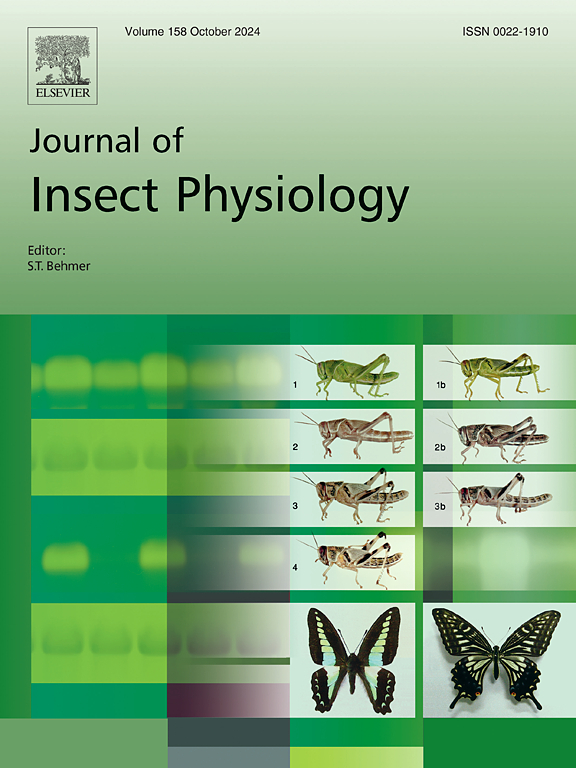Insect gut-dwelling fungus Zancudomyces culisetae: A hidden player in mosquito development
IF 2.3
2区 农林科学
Q1 ENTOMOLOGY
引用次数: 0
Abstract
Mosquitoes and their gut-dwelling fungi have been documented worldwide, yet their relationships remain poorly understood. Harpellales fungi (Kickxellomycotina, Zoopagomycota) have traditionally been considered commensals, but recent studies suggest they may exhibit parasitic or mutualistic characteristics under certain conditions. In this study, we explored these interactions using two well-established laboratory models: Aedes aegypti and Zancudomyces culisetae. Specifically, we investigated the impact of the gut-dwelling fungus Z. culisetae on A. aegypti larval development by measuring body size and development time under different nutritional conditions, with or without the fungus in the hindgut. Significant differences in body size and development time were observed during larval development in the presence of the gut fungus compared to the control group. Larvae colonized by the fungus exhibited larger body sizes and accelerated development. These effects were consistent under both nutrient-rich and nutrient-deficient conditions, underscoring the symbiotic roles of the gut-dwelling fungus. Interestingly, our results also revealed that even dead fungal spores enhanced mosquito larval development, suggesting previously unrecognized beneficial mechanisms associated with the fungal tissue. Transmission electron microscopy provided additional evidence of mosquito-fungus interactions, showing electron-dense particles within mosquito cells at sites of close contact with fungal cells, although further investigation is required to confirm their identity. Collectively, our findings challenge the traditional view of insect relationships with gut-dwelling fungi, providing evidence for a potential shift from commensalism to mutualism.

寄生于昆虫内脏的真菌:蚊子发育过程中一个隐藏的角色
蚊子和它们的肠道真菌在世界范围内都有记载,但它们之间的关系仍然知之甚少。Harpellales真菌(Kickxellomycotina, Zoopagomycota)传统上被认为是共生的,但最近的研究表明,它们可能在某些条件下表现出寄生或共生的特征。在这项研究中,我们使用两个完善的实验室模型:埃及伊蚊和culisetae赞库菌来探索这些相互作用。具体而言,我们通过测量不同营养条件下(后肠有无真菌)的体型和发育时间,研究了肠道真菌对埃及伊蚊幼虫发育的影响。与对照组相比,在肠道真菌存在下的幼虫发育过程中,观察到体型和发育时间的显著差异。被真菌定殖的幼虫体型较大,发育加快。这些影响在营养丰富和营养缺乏的条件下都是一致的,强调了肠道真菌的共生作用。有趣的是,我们的研究结果还表明,即使是死亡的真菌孢子也能促进蚊子幼虫的发育,这表明了以前未被认识到的与真菌组织相关的有益机制。透射电子显微镜提供了蚊子-真菌相互作用的额外证据,在与真菌细胞密切接触的地方显示蚊子细胞内的电子密集颗粒,尽管需要进一步调查以确认其身份。总的来说,我们的发现挑战了昆虫与肠道真菌关系的传统观点,为从共生到互惠的潜在转变提供了证据。
本文章由计算机程序翻译,如有差异,请以英文原文为准。
求助全文
约1分钟内获得全文
求助全文
来源期刊

Journal of insect physiology
生物-昆虫学
CiteScore
4.50
自引率
4.50%
发文量
77
审稿时长
57 days
期刊介绍:
All aspects of insect physiology are published in this journal which will also accept papers on the physiology of other arthropods, if the referees consider the work to be of general interest. The coverage includes endocrinology (in relation to moulting, reproduction and metabolism), pheromones, neurobiology (cellular, integrative and developmental), physiological pharmacology, nutrition (food selection, digestion and absorption), homeostasis, excretion, reproduction and behaviour. Papers covering functional genomics and molecular approaches to physiological problems will also be included. Communications on structure and applied entomology can be published if the subject matter has an explicit bearing on the physiology of arthropods. Review articles and novel method papers are also welcomed.
 求助内容:
求助内容: 应助结果提醒方式:
应助结果提醒方式:


